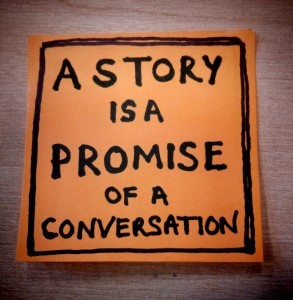Can you go a day without sharing a story? For 24 hours, you won’t be able to talk to your friends or tell your family how your day went. On Facebook, you can’t comment about the weather nor will you be able to share viral challenges you’re trying out.
Sounds impossible? That’s because it probably is. People are hardwired to be social beings, and part of that is our need to communicate with one another.

If storytelling is integrated into our everyday routine, why do we leave it out of our presentations? When we address an audience, we tend to focus on the important points we need to convey. We talk about data or explain a business model.
Sometimes, we turn back to our slides to display a graph. We concentrate on information that’s crucial to the outcome we’re hoping for. Despite all this, we tend to leave out something that seems just as vital. We forget to answer why everyone in the room needs to hear what we have to say.
This is where storytelling comes in handy. A presentation with a story has something more than a list of numbers that prove your business plan is viable. Take this scenario narrated by Dennis Nishi in an article for the Wall Street Journal:
Paul Smith had 20 minutes to sell the CEO of Procter & Gamble, and his team of managers, on new market-research techniques for which Mr. Smith’s department wanted funding. As associate director of P&G’s market research, Mr. Smith had spent three weeks assembling a concise pitch with more than 30 PowerPoint slides.
… “I felt like maybe I hadn’t done a very good job because he wasn’t looking at my slides like everyone else,” says Mr. Smith, who also noticed that the other managers didn’t seem very engaged. “It didn’t occur to me until later that he did that because he was more interested in what I had to say than in what my slides looked like.”
Like most people, Paul worked hard to hone his pitch into a PowerPoint deck. Despite his effort, he noticed that the people he was trying to convince seemed disengaged to what he presenting. As he later realized, a successful presentation goes beyond what your slides look like. What really matters is the heart of what you’re trying to say.
Storytelling in Presentations: A Tale as Old as TED
The reason storytelling is an effective presentation technique lies on how your audience reacts to it. As social beings, we’re all naturally attuned to our emotions.
Time for another challenge. This time, take a minute to list down 10 of your favorite movies. Looking at your list, think about why these movies made an impact on you. I’ll wager it’s because they were able to connect with you on an emotional level.
It doesn’t matter whether it makes you sad, happy, angry, or nostalgic. Our brains love a good story that makes us feel something. This is something successful TED presenters have capitalized on. If you review the list of the most viewed TED Talks, you’ll see each of them has a story integrated into the discussion.
As Forbes contributor Nick Morgan points out, “no matter how interesting the information, you’ll run up against the limitation of the brain and quickly overtax your audience…If instead you tell your audience a story, you get to jump right into the deeper parts of their brain, where emotion and memory work together, the hippocampus and amygdala.”
Integrating Storytelling in Business
Now, the only question that remains is how. It’s pretty easy to create a heart-warming story for an inspirational presentation. The real challenge is turning data into a narrative that packs an emotional punch. How do you do it? According to presentation expert Bruce Gabrielle, you’ll need to follow a simple but effective structure: Beginning, Middle, End.

Beginning
Start your presentation by identifying a hero that your audience can relate to. Instead of leading with numbers or graphs, introduce a human element into your presentation. There is always a face behind all the abstract concepts and issues you’re taking on. To identify it, tackle your presentation using a different angle.
Substitute “what” with “who do I really want to talk about?” For example, if you’re trying to discuss a marketing strategy, your hero could be a potential client. Describe the person you want to engage with your services. Talk about their demographics, traits, and values.
Middle
What would your favorite movie be like without conflict? Like any good story, business presentations also need a bit of tension. Apart from his or her goals, you also have to identify the challenges and risks faced by your hero.
What are the things that bother your potential clients? What’s preventing them from engaging with your services?
End
After building conflict, offer your audience some reprieve by giving them a satisfying resolution. At this point, you can put everything together and focus on data necessary to your discussion. While explaining the graph on your slides, keep referring back to your hero. What do these numbers have to do with the hero of your story? How does it solve the problems you identified earlier?
To give your stories more impact, try to make use of captivating visuals as well. While your narrative is certainly the most important part of your presentation, visuals remain to be an effective way to enhance audience immersion.
Conclusion
Apart from working on a short PowerPoint deck, try to make use of words that generate mental images. Make use of vivid descriptions and action words to allow some room for imagination.
Not only is storytelling an integral part of our daily lives, it can also be a powerful presentation technique. Turn dull data and information into a feast for the imagination by learning to craft your own presentation story.

Download free PowerPoint templates now.
Get professionally designed PowerPoint slides weekly.
Sign Up NowReferences
Gabrielle, Bruce. “Storytelling in the Boardroom: Part 3 – Three Secrets for Better Stories.” Office Blogs. Accessed September 9, 2014.
Morgan, Nick. “Three Secrets To Delivering A Powerful Speech.” Forbes. Accessed September 4, 2014.
Myers, Courtney Boyd. “Why the Human Is a Social Animal [Report from the 99% Conference].” TNW Network. May 05, 2011. Accessed September 9, 2014.
Featured Image: Horia Varlan via Flickr








